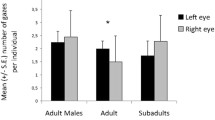Summary
-
1.
In the vicinity of an underwater substrate (e.g., a wall) certain fishes tend to maintain a body posture with their ventral sides oriented towards the substrate.
-
2.
This paper gives the first comparative data on thisVentral Substrate Response (VSR). It furthermore extends the present concept of theVSR, which has so far only been studied with regard to body roll responses, by including observations ofVSRs about the pitch axis. The rollVSR was termedVSRr, theVSR with the head in an upward position was namedVSRpu, and theVSR with the head pointing downward was given the nameVSRpd.
-
3.
In some species allVSR forms may show a high gain whereas in others the gain ofVSRpu andVSRpd can be high and the gain of theVSRr is low. The question is raised whether this finding suggests a possible independence of the mechanisms controllingVSRs about the roll andVSRs about the pitch axis.
-
4.
In fish, that are shown to guide theirVSRs visually, unilateral enucleation does not abolish theVSR behavior, if the seeing eye looks towards the substrate. Binocular interaction is thus not essential for this response. Other observations of unilaterally blinded animals led to the discovery of a new domain of support for the hypothesis that theVSR mechanisms are independent of those guiding theDorsal Light Response: rolling tendencies towards the intact eye occuring when the fish are kept in an environment lacking visible objects cease if such objects are introduced into the test tank. The independence ofVSR andDorsal Light Response mechanisms is also demonstrated by the fact that unilaterally enucleated fish show aVSRr at all.
-
5.
VSRpu andVSRpd were studied in the weakly electric fishEigenmannia sp. These experiments revealed that, as earlier shown for theVSRr alsoVSRpu andVSRpd may be guided by non-visual cues in certain species.
Similar content being viewed by others
References
Bogenschütz, H.: Vergleichende Untersuchungen über die optische Komponente der Gleichgewichtshaltung bei Fischen. Z. vergl. Physiol.44, 626–655 (1961)
Buddenbrock, W.v.: Über die Orientierung der Krebse im Raum. Zool. Jahrb. Allg. Zool.34, 479–515 (1914)
Holst, E.v.: Über den Lichtrückenreflex bei Fischen. Pubbl. Staz. Zool. Napoli15, 143–158 (1935a)
Holst, E.v.: Die Gleichgewichtssinne der Fische. Verhandl. Dtsch. Zool. Ges. 1935, 108–114 (1935b)
Holst, E.v.: Der Einfluß der nichtbelichteten Retina auf das Gleichgewichtsverhalten von Fischen. Naturwissenschaften41, 507–508 (1954)
Main, R.J.: Phototropism in fishes, and its relation to the results obtained by eye-dislocation. Z. vergl. Physiol.7, 611–616 (1928)
Meyer, D.L., Heiligenberg, W., Bullock, T.H.: The ventral substrate response. A new postural control mechanism in fishes. J. comp. Physiol.109, 59–68 (1976)
Meyer, D.L., Platt, C., Distel, H.-J.: Postural control mechanisms in the upside-down catfish (Synodontis nigriventris). J. comp. Physiol.110, 323–331 (1976)
Author information
Authors and Affiliations
Additional information
Supported by the “Deutsche Forschungsgemeinschaft” (ME 526/3) and by NASA, NIH, and NSF grants to Dr. T.H. Bullock
We wish to thank Prof. T.H. Bullock and Prof. P. Glees for critically reading this manuscript.
Rights and permissions
About this article
Cite this article
Meyer, D.L., Becker, R. & Graf, W. The ventral substrate response of fishes. J. Comp. Physiol. 117, 209–217 (1977). https://doi.org/10.1007/BF00612787
Received:
Issue Date:
DOI: https://doi.org/10.1007/BF00612787




